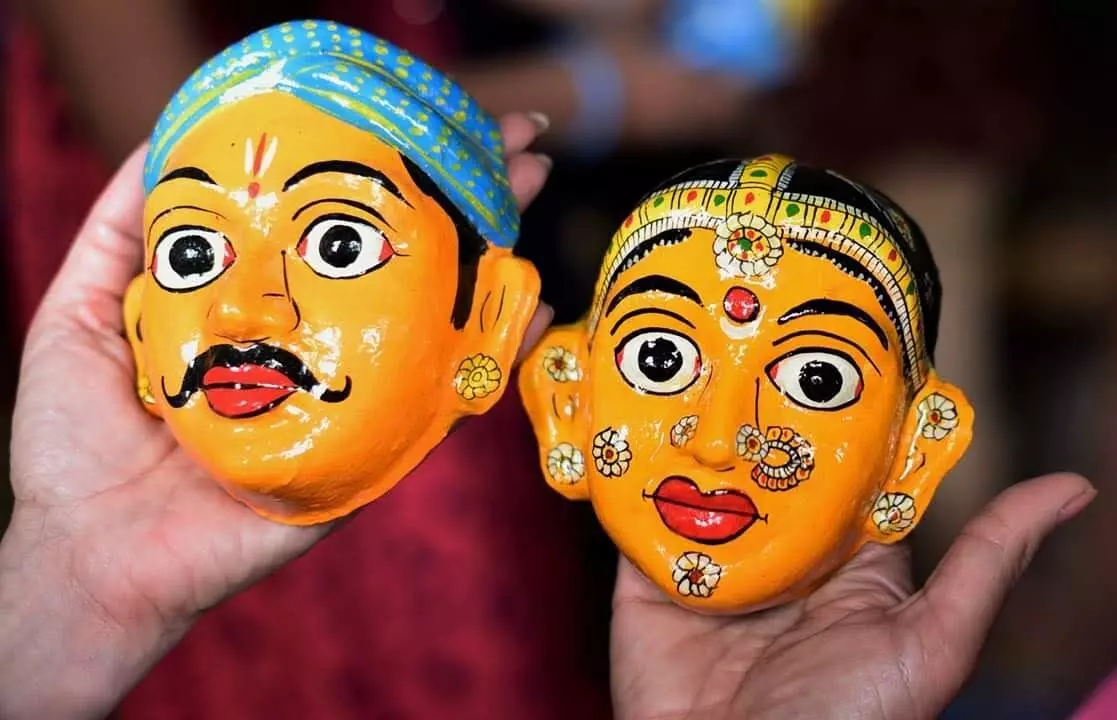How a Telangana family is preserving & modernising ancient Cheriyal painting
Cheriyala scroll paintings have been a symbol of genealogies for centuries
By Nikisha Uddagiri
Cheriyala masks made from a dried coconut shell
Hyderabad: Cheriyala Nakashi, a traditional art form that fuses mythology, faith, and social consciousness, has gained international fame in recent years. This art form, also known as Cheriyala scroll paintings or map paintings, has been a symbol of dozens of genealogies for centuries.
Pasula Mallesham, born into a family in Cheriyal that has been rolling beedis for generations, decided to pursue the ancient art form of his village. He passed on his knowledge to his wife, Pasula Manga, and together, they have committed their lives to preserving this tradition.
Only seven families in the world continue to practice the 400-year-old art form, and currently, just two families in Cheriyal are keeping this tradition alive. Pasula’s family is one of them who are committed to preserving the art form.
For Manga, the art of Cheriyal paintings is not just a way to create beautiful artwork, it’s a way of life. “I learned the art from my husband, and today, I’m an entrepreneur and a teacher, generating employment for local women by teaching them the art form.”
Creating Cheriyal paintings involves using a unique paste made from tamarind powder, wood powder, and coconut shells, which are then adorned with natural colours. Unlike modern techniques, this traditional art form is completely handmade, with no chemicals or machinery involved in the process.
“The hard work, patience, and concentration required to make these paintings are physically exhausting, affecting our knees, eyes, and neck,” says Manga. However, the family is committed to keeping the art form alive and relevant in modern times.
Manga explains that despite the physical demands of creating Cheriyal paintings, her family remains dedicated to preserving the tradition. They have adapted their art with a modern touch, creating wall paintings, key chains, and face masks to keep up with the times.
For the Pasula family, Cheriyal paintings are a family affair. Manga says, “We work together to make these paintings at home, with even the children helping to manage stalls during exhibitions.” Together, they plan to set up an exclusive online platform for Cheriyal paintings, a dream that they hope will soon become a reality.
Manga reminisces about the initial challenges in making their Cheriyala paintings accessible to a broader audience. In the past, she relied on selling her artwork only through the Lepakshi emporium. “But in 2020, our fortunes changed when we partnered with WeHub, a startup incubator supported by the Telangana government, which helped us to reach a larger market,” Manga adds.
Through their dedication and hard work, the Pasula family is preserving an ancient tradition and ensuring that the art of Cheriyal painting continues to thrive. Their story serves as an inspiration to others, showing that with passion, perseverance, and innovation, ancient traditions can be preserved and modernised for future generations to enjoy.
Preserved for centuries
The Cheriyala paintings were traditionally used as a means of imparting social consciousness in the villages of Telangana, with a 20-foot map spread displaying mythological knowledge. Aravind Arya, a historian from Warangal says, "The emergence of various castes was showcased in the Kulapuranas, which explained the livelihood of the dependent castes of each respective caste. Telangana has 400 hundred years of unique Cheriyala map images, with the village of Cheriyala in Siddipet district becoming particularly renowned for its 50-foot long and 4-foot-wide rainbow of colourful paintings."
Vivid colours and fascinating stories
One of the notable aspects of the Nakashi art form is that the figures drawn once remain intact for two or three decades, with huge images ranging from six feet to 60 feet in length stored and wrapped in mats. Aravind adds, "The name Nakashi is said to have originated from the Urdu word for ‘fine work,’ which the Nizam lords used to call the artists responsible for creating decorative items."
The art form also includes unique background stories, known as Kula Puranas, which describe the origin and greatness of various castes. These legends are carved onto the maps and given to the dependent castes, with village legend-telling programmes organised in the evening based on these stories. Natural dyes, including gum extracted from Tirumani trees, lamp soot, conch powder, and vegetable dyes, are used to create the vibrant colours that make Cheriyala Nakashi so distinct.
From museums to marketplace
The Cheriyala paintings have been showcased in various museums, including Hyderabad’s Salarjung Museum, which houses maps dating back to the 17th century. They have also been featured in museums in London and Paris, with one image even appearing on the cover of a book in the British Museum. These paintings are available for purchase at Haritha Kakatiya Hotel, Golkonda, Lepakshi, Shilparamam, as well as other handicraft outlets and e-commerce websites like Amazon and Flipkart.